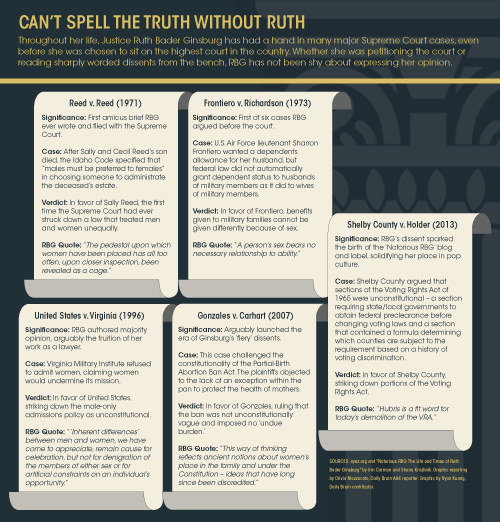Museum review: Ruth Bader Ginsburg exhibit does judge’s legacy justice

Notorious RBG: The Life and Times of Ruth Bader Ginsburg
Skirball Cultural Center
Until Mar. 10, 2019
Prices vary
By Olivia Mazzucato
Nov. 19, 2018 11:43 p.m.
Supreme Court Justice Ruth Bader Ginsburg and rapper the Notorious B.I.G. don’t have much in common on the surface, but Biggie inspired Ginsburg’s nickname – the Notorious RBG. The nickname was coined by a law student who was inspired by Ginsburg’s attitude after her fiery dissent in Shelby County v. Holder, and helped build her reputation as a “badass.”
“Notorious RBG: The Life and Times of Ruth Bader Ginsburg,” a new exhibit at the Skirball Cultural Center, celebrates Ginsburg’s pop culture nickname and legacy. Based on the book of the same name, the exhibit uses a storytelling approach that takes advantage of multimedia displays to tell Ginsburg’s story and craft an earnest love letter to the justice.
The chronological exhibit starts with installments that highlight Ginsburg’s childhood and education, and follows her career path from American Civil Liberties Union lawyer to justice on the most powerful court in the country. Rather than compartmentalizing each period of her life into its own room, the exhibit takes place in one large room and segments the different portions using Biggie’s lyrics, such as those from “Stereotypes of a Lady Misunderstood” and “I Got a Story to Tell.” The openness helps make the exhibit feel less like a regimented lesson and more like an adventure, allowing viewers to move through Ginsburg’s life while also seeing the bigger picture and gravitating toward the parts of Ginsburg’s story that most intrigue them.
To augment the storytelling, the exhibit uses elements besides just traditional text descriptions, photos and artifacts. In addition, designed sets place visitors in locations from Ginsburg’s life and explain its key motifs. One of the first elements of the exhibit is a recreation of Ginsburg’s childhood living room. Within the room are everyday objects like a copy of an editorial Ginsburg wrote as a child and favorite books that she read growing up.
While the items help set the scene, they also establish themes that run throughout the exhibit. Ginsburg’s editorial focuses on the importance of treating all people equally, a key thread of her career as a lawyer and a judge. The books are explained as examples of the way in which Ginsburg’s mother supported her education and growth, the first in a series of relationships demonstrating the importance of Ginsburg’s support system throughout her life.
Another notable feature of the exhibit is the way it brings Ginsburg and those in her orbit to life, making them feel like characters acting in a story rather than relics or distant historical figures. The relationship between Ginsburg and her husband Martin Ginsburg is a constant thread throughout the exhibit, and he is portrayed as someone who recognized her as his equal and respected her and her work. The dynamic is sweetly encapsulated in a set of their shared kitchen, complete with a book of Martin Ginsburg’s recipes and the final letter he left for his wife when he died.
A wall display and artifact case highlight the work of Pauli Murray, a civil rights activist and lawyer whose work on gender discrimination inspired Ruth Bader Ginsburg. Furthermore, she cited Murray as a co-author in one of the amicus briefs she authored and filed with the Supreme Court. The display includes a photo and biography of Murray, as well as a tongue-in-cheek letter she sent to former President Richard Nixon, in which she applies to be a Supreme Court justice despite knowing the conservative president wouldn’t select her. In doing so, Murray wanted to make sure Nixon couldn’t say qualified female candidates of color had not come across his desk. The fact that the exhibit gives credit to people besides Ginsburg is both a credit to the curators and a reflection of Ginsburg’s style and outlook, through which she attempts to amplify the work of others.
Ginsburg is best known for her time as a Supreme Court justice, so the exhibit briefs her most notable cases on display boards but adds dimension to the displays by including headphones playing oral arguments. The audio serves to further breathe life into a display that could feel more like a textbook, allowing readers to hear Ginsburg questioning the lawyers while representing the plaintiffs or delivering opinions from the bench.
Visitors get a chance to step into Ginsburg’s shoes near the end of her timeline in a photo dress-up opportunity complete with robes and Ginsburg’s infamous collars as well as a backdrop of the Supreme Court bench. The black judicial robes and replicas of Ginsburg’s infamous decorative collars almost feel like superhero costumes, even if visitors only get to wear them for a few minutes.
Even for visitors who aren’t political whizzes or RBG fans willing to dress up in costume, the exhibit is very accessible, breaking things down into everyday language and even helpfully featuring charts and brochures that explain the different branches of government.
Perhaps the only downside of the exhibit is the price. The Skirball Cultural Center charges $9 for admission when presented with a student ID, which is not prohibitively expensive but can feel a little steep. Nevertheless, the immersive escapism of the exhibit makes it a price worth paying to spend a few hours living in the world of the Notorious RBG.


